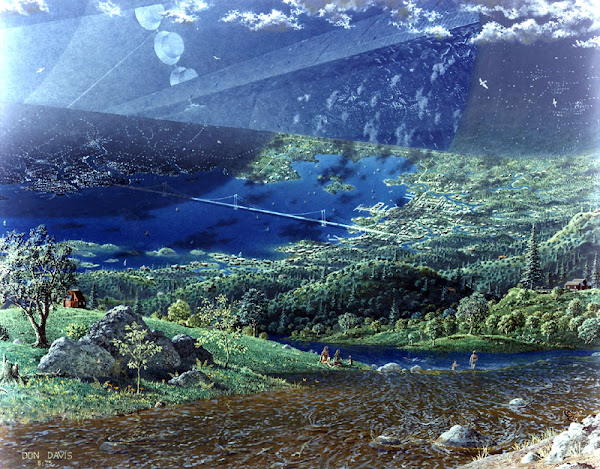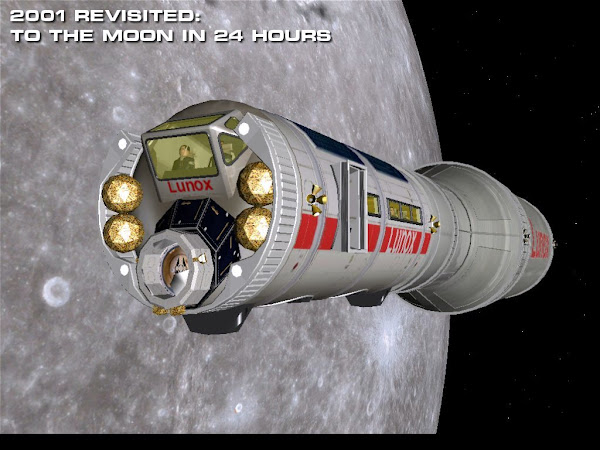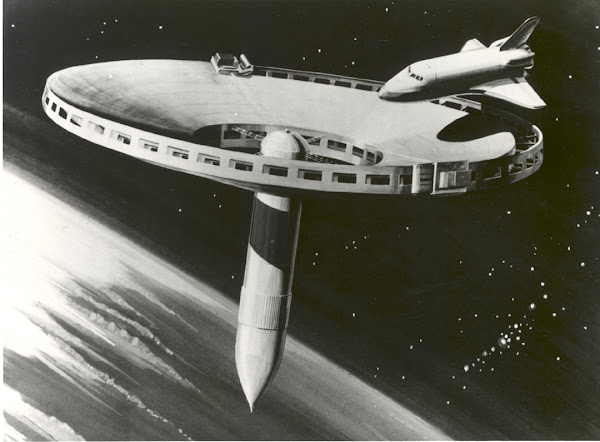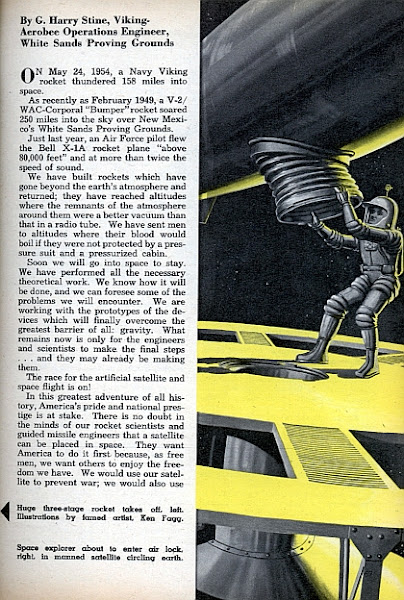Technology and engineering discussion of possible space colonies designs. Space colonies, spaceships, design and technology for living in space, etc.
Below are a few examples. You can click on images for a much larger version.Stanford Torus
The Stanford Torus was the principal design considered by the 1975 NASA Summer Study, which was conducted in conjunction with Stanford University (and published as
Space Settlements: A Design Study, NASA Publication SP-413). It consists of a torus or donut-shaped ring that is one mile in diameter, rotates once per minute to provide Earth-normal gravity on the inside of the outer ring, and which can house 10,000 people.

Stanford Torus external view. The overhead mirror brings sunlight into the colony through a series of louvred mirrors on the inner ring. Painting by Don Davis courtesy of NASA.

Stanford Torus cutaway view. The rotation of the torus provides Earth-normal gravity on the inside. Painting by Rick Guidice courtesy of NASA.

Stanford Torus interior. It seems unlikely that early colonies will have a population density this low. Painting by Don Davis courtesy of NASA.

Stanford Torus agriculture, conducted on multiple tiers for efficient use of space. Agriculture in space can be very productive because of the controlled environment. Painting courtesy of NASA.

Stanford Torus construction. Depicted is the final stages of installation of the radiation shielding. Painting by Don Davis courtesy of NASA.
Source: Stanford TorusBernal Sphere
The Bernal Sphere design is very similar to that used in the science fiction series Babylon 5, although the original Bernal Sphere design is much smaller, only 1 mile in circumference, and can house 10,000 people.

Bernal Sphere external view. It was later learned that the mirrors won't work properly in this configuration and will need to be redesigned. Painting by Rick Guidice courtesy of NASA.

Bernal Sphere cutaway view. The sphere rotates twice per minute to provide Earth-normal gravity on the inside. Painting by Rick Guidice courtesy of NASA.

Bernal Sphere agricultural rings seen in cross-section. Farming occurs in the upper layers, and animal husbandry in the lower layers where gravity is a little stronger. Painting by Rick Guidice courtesy of NASA.

Bernal Sphere interior, complete with California-style wine and cheese party, and human powered flight in the lower-gravity area near the axis. Painting by Rick Guidice courtesy of NASA.

Bernal Sphere hub still in the construction phase, with shielding and mirrors being installed. Painting by Don Davis courtesy of NASA.

Bernal Sphere low-gravity recreation area at dusk, protected by netting. Gravity becomes lower as you approach the center, and at the very top are the zero-gravity honeymoon suites. Painting by Don Davis courtesy of L5 News and National Space Society.
Source: Bernal SphereO'Neill Cylinder
The O'Neill Cylinder, designed by Princeton physicist Gerard K. O'Neill, is considerably larger than the other two designs, and is referred to as an "Island 3" or 3rd-generation space colony. The configuration consists of a pair of cylinders, each 20 miles long and 4 miles in diameter. Each cylinder has three land areas alternating with three windows, and three mirrors that open and close to form a day-night cycle inside. The total land area inside a pair of cylinders is about 500 square miles and can house several million people. The cylinders are always in pairs which rotate in opposite directions, cancelling out any gyroscopic effect that would otherwise make it difficult to keep them aimed toward the sun.

O'Neill Cylinder exterior. The modules on the large ring structure around the endcap are used for agriculture. Each module could have differing environments ideal for a particular set of food items. Painting by Rick Guidice courtesy of NASA.

O'Neill Cylinder interior provides a 20-mile vista. Children born here would think it totally normal to have "upside down" land areas overhead. Painting by Rick Guidice courtesy of NASA.

A dramatic side view of an O'Neill Cylinder showing a cloud level forming at an altitude of 3000 feet. Painting copyright by Don Davis courtesy of the artist.

O'Neill Cylinder endcap. The artist's inspiration came after O'Neill suggested to him that the view of San Francisco and the Golden Gate Bridge from Sausalito would provide an excellent scale reference for a later model cylindrical colony. Painting by Don Davis courtesy of NASA.

O'Neill Cylinder vista with ruddy hues caused by a fairly rare solar eclipse. The cylinders are large enough to have weather, which could even be made to change with the seasons, perhaps depending on a colonist vote. Painting by Don Davis courtesy of NASA.
Source: O'Neill Cylinder






















































